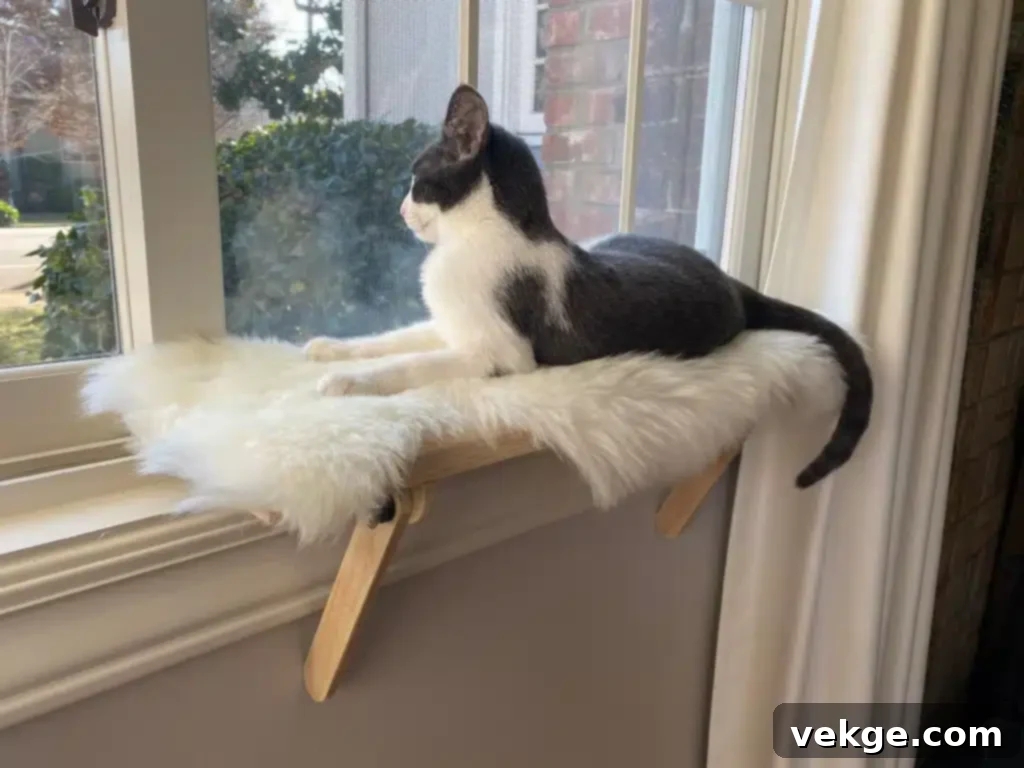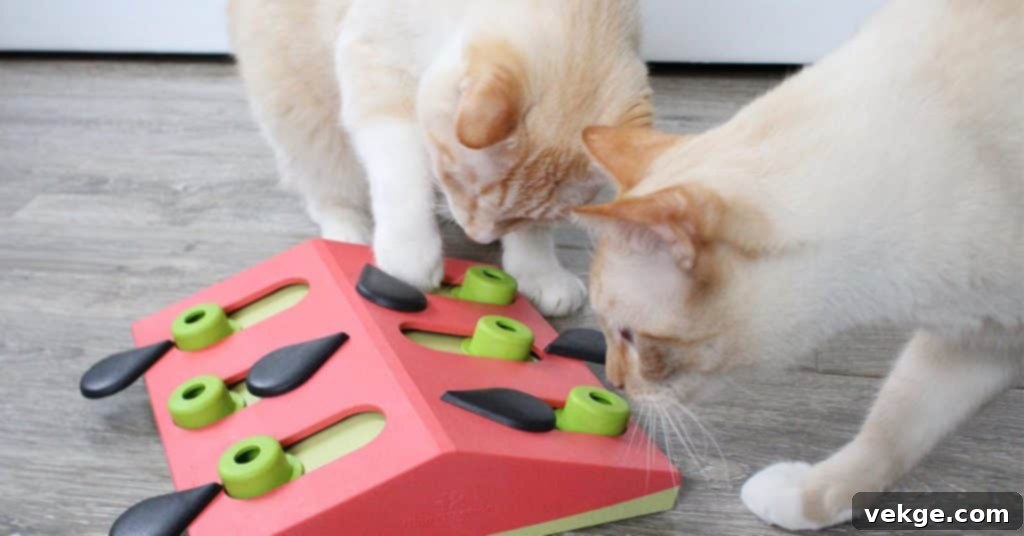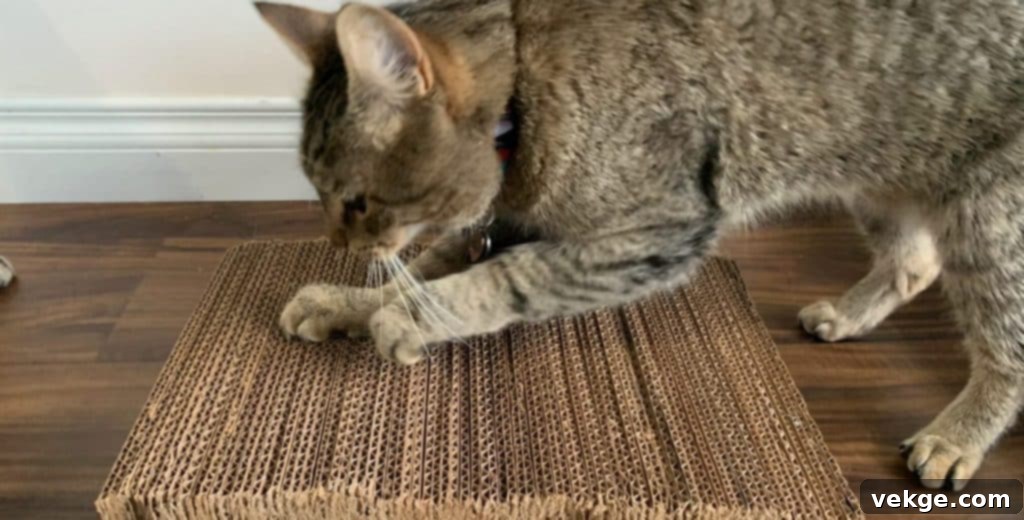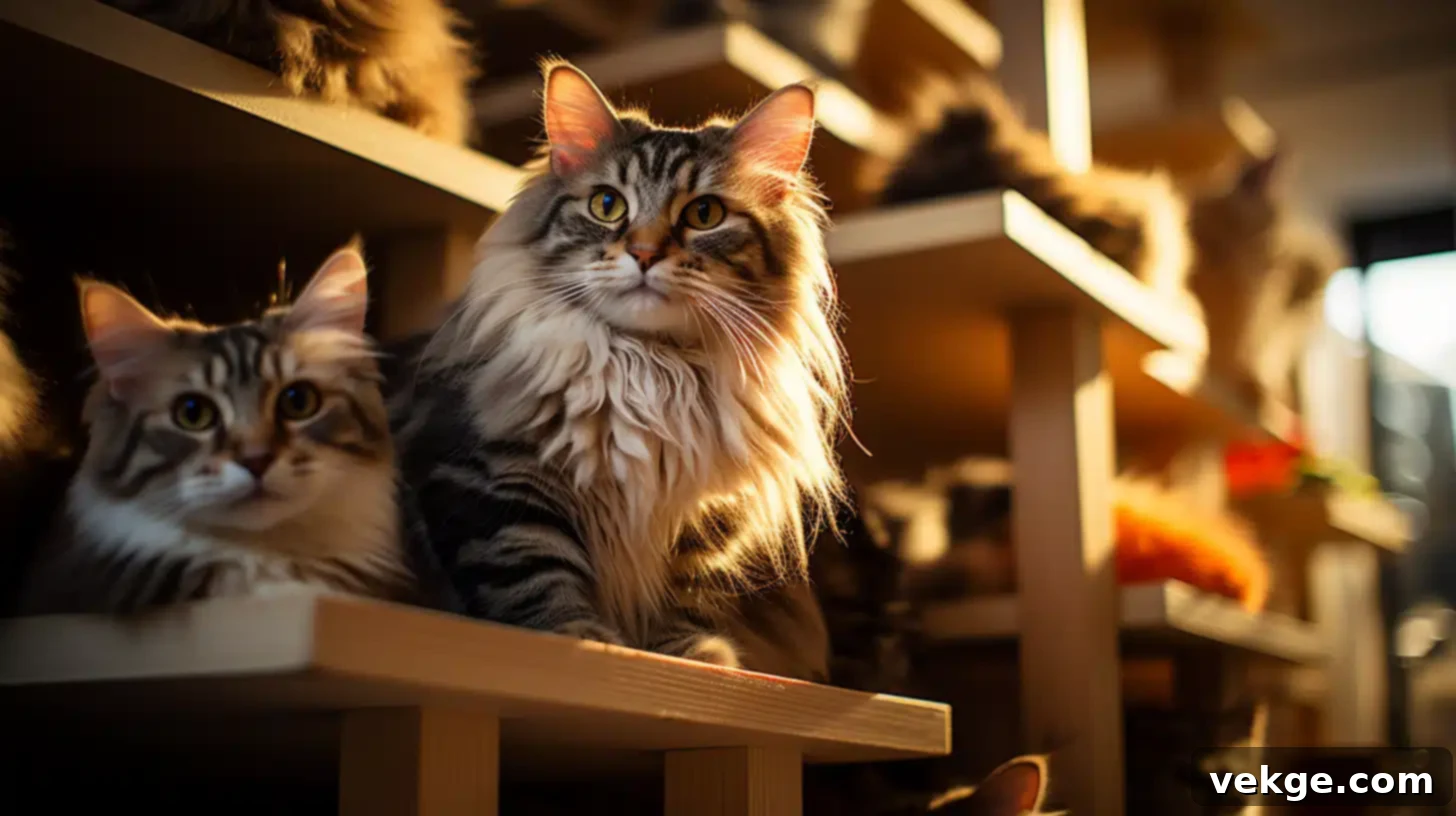Creating the Ultimate Cat-Friendly Home: A Comprehensive Guide to Feline Happiness
Cats are cherished members of our families, and their well-being is a top priority for any pet owner. These curious and agile creatures thrive in environments that offer both security and stimulation, allowing them to express their natural instincts to run, play, hunt, eat, and rest comfortably. While domestic cats bring immense joy, their mischievous nature means protecting them from potential hazards, and providing ample opportunities for enrichment, is crucial. A thoughtfully designed home not only keeps your feline friend safe and engaged but also offers you peace of mind, whether you’re at home or away.
Designing a home that caters to your cat’s unique needs doesn’t have to be complicated. By focusing on key areas, you can transform your living space into a true feline sanctuary. From cozy napping spots to engaging play zones, every element contributes to a happier, healthier cat. Here are six essential elements you need to consider when creating a safe, secure, and truly enriching living space for your beloved felines.
1. The Importance of Comfortable and Diverse Cat Beds

Cats are notoriously particular about their resting spots, often rotating through various locations throughout the day as their mood or the sunlight dictates. It’s a common scenario for owners to invest in a plush cat bed, only to find their feline companion prefers an old cardboard box or a discarded couch cushion. This pickiness isn’t a rejection of your generosity; rather, it highlights a cat’s innate desire for options and comfort that meets their specific needs at any given moment.
Providing your pet with a variety of sleeping options is a wise strategy to ensure they always have a comfortable and secure place to rest. Look for beds specifically tailored for cats, designed to make them feel safe, warm, and cocooned. These can range from soft, donut-shaped beds that allow them to curl up, to covered “cave” beds that offer a sense of privacy and security. The key is offering diversity in shape, texture, and location.
For cats that enjoy elevated positions – a natural instinct stemming from their predatory desire to observe their surroundings – a tall cat tree equipped with integrated beds or platforms at various levels is an excellent investment. These multi-tiered structures provide a safe perch where your feline can survey their “territory,” feel secure, and enjoy a comfortable nap. Consider a tree with different textures like sisal for scratching and soft fabric for napping.
Furthermore, cats with special needs, such as senior felines or those with medical conditions like arthritis, may require uniquely crafted beds to provide essential support. Orthopedic pet sofas, for example, often feature memory foam bases that conform to their body, alleviating joint pain, and may include raised bolsters or pillows to support their head and neck. Heated beds can also be incredibly soothing for older cats or those in colder climates, offering therapeutic warmth that eases aches and promotes deeper rest. By understanding your cat’s individual preferences and physical requirements, you can ensure they have the perfect spot to recharge and feel completely at ease.
2. Enhancing Their World with a Window Perch

For the majority of indoor cats, venturing into the great outdoors is a rare event, primarily due to safety concerns. While an occasional quick dash out the door might occur, most felines remain safely within the confines of the home. However, this doesn’t mean they can’t experience the sights, sounds, and stimulation of the world outside. Cats possess a strong innate curiosity and a natural inclination to observe their environment, making a window perch an indispensable addition to any cat-friendly home.
A window perch provides a safe and elevated viewing area, allowing your cat to indulge in one of their favorite pastimes: watching the yard. From this vantage point, they can patrol the area for birds, squirrels, leaves rustling in the wind, or even just the subtle movements of passersby. This “cat TV” offers immense mental stimulation, fulfilling their predatory instincts without putting them at risk. The dynamic visual input keeps their minds active and prevents boredom, which can often lead to destructive behaviors.
Window perches come in a myriad of shapes, sizes, and attachment styles, so finding one that your cat genuinely enjoys might involve a bit of experimentation. Options range from simple, cushioned shelves that attach to the windowsill, to more elaborate hammock-style perches that use suction cups to adhere directly to the glass, providing an unobstructed view. Some even integrate into existing cat trees or furniture. When selecting a perch, consider its stability and the weight capacity to ensure it can safely support your cat.
Beyond wildlife viewing, felines also revel in basking in the warmth of natural sunlight. A well-placed window perch in a spot that receives ample sun throughout the day becomes a cherished sunbathing station. The warmth helps regulate their body temperature, soothes muscles, and provides a sense of comfort. It’s not uncommon for cats to spend hours stretched out on their sunny perch, perhaps even sleeping more soundly there than in their designated beds, simply because it combines warmth, an elevated position, and the ever-present entertainment of the outdoor world. This simple addition can significantly enhance your indoor cat’s quality of life, connecting them to nature from the safety of your home.
3. Unleashing Their Instincts with Stimulating Toys

Despite their domesticated lives, cats retain their deep-seated instincts as natural predators. While a 2021 study revealed that domestic felines receive a vast majority (96%) of their food indoors, a small percentage (about 4%) still comes from opportunistic hunting of wild animals. This inherent drive means that even the most pampered housecat yearns for opportunities to hunt, chase, and capture – even if their “prey” consists of fabric, synthetic fur, or a laser dot. Providing a variety of stimulating toys is paramount to appealing to these instincts, encouraging healthy playtime, and preventing boredom or destructive behaviors.
A diverse array of toys keeps cats engaged. Simple yet effective options include motorized mice, which mimic unpredictable prey movements. Wind up the gadget and watch your pet’s eyes light up as they stalk and chase it across the floor. This type of toy offers excellent physical exercise and satisfies their hunting sequence.
For mental stimulation, puzzle toys and food mazes are invaluable. These interactive gadgets challenge your feline to work for their treats, requiring problem-solving skills to unlock rewards. Figuring out how to maneuver the toy to release a piece of kibble or a small treat engages their brain, sharpens their cognitive abilities, and makes dinnertime a more rewarding and fun experience. This “work to eat” concept, often referred to as enrichment feeding, also helps slow down fast eaters and prevent boredom-related overeating.
Beyond these, consider a rotation of different toy types: feather wands for interactive play with you, crinkle balls, catnip-filled mice, kickers, and even simple crumpled paper or empty cardboard boxes. Rotating toys keeps them fresh and exciting, preventing your cat from becoming jaded. Interactive play with a wand toy not only strengthens your bond but also allows your cat to practice their pouncing and stalking skills in a safe environment. By offering a rich variety of stimulating toys, you ensure your cat’s physical and mental health are well-catered for, leading to a happier, more well-adjusted companion.
4. Ensuring Outdoor Safety with a Cat Fence or Enclosure
For cats that enjoy a balance of indoor and outdoor living, or for owners who wish to provide safe outdoor access, robust external protection is absolutely necessary. Fences and specialized cat enclosures (often called “catios”) are excellent options as they confine your cat to a specific, secure area, protecting them from dangers like traffic, predators, and getting lost, while also protecting local wildlife. When considering cat fences, quality and design are paramount, as intelligent and agile felines can often overcome poorly constructed barriers. The last thing any cat owner wants is the distress of losing their beloved pet because they managed to breach an inadequate fence.
Firstly, the materials and design of your fence demand careful consideration. Cats possess a natural desire to climb and explore. Standard wooden fences, with their rough texture and horizontal slats, provide ample grip for claws, essentially inviting cats to scale them. To deter climbing, opt for smooth, difficult-to-grip materials like vinyl, metal, or smooth-coated wire mesh, which significantly reduce their traction. The height of the fence is also critical; a minimum of 6-8 feet is generally recommended, but even then, determined climbers might find a way over.
For existing fences, or for enhanced security, several cat-proofing solutions can be added. “Coyote rollers” are a highly effective option. These are often PVC pipes or similar rolling mechanisms installed along the top of a fence. When a cat (or coyote) attempts to climb over, the roller spins, preventing them from getting a purchase and safely dropping them back into the yard. Outward-angled mesh extensions or netting systems, extending inwards from the top of the fence, also create an overhang that makes it nearly impossible for cats to climb out. These systems can transform a standard fence into a cat-proof barrier.
Another increasingly popular option is the “catio” – a dedicated, enclosed outdoor patio or enclosure specifically designed for cats. Catios provide a completely secure space where cats can enjoy fresh air, sunshine, and sensory stimulation without any risk of escape or exposure to dangers. They can range from small window box enclosures to elaborate multi-level structures with ramps, shelves, and scratching posts, connecting to the house via a cat flap. A well-designed cat fence or catio offers the perfect compromise, giving your feline friend the best of both worlds: the safety of home with the enriching experience of the outdoors.
5. Protecting Furniture with Strategic Scratching Posts

Cats are meticulous groomers, and their paws and claws play a central role in maintaining their hygiene and overall well-being. Keeping their nails in tip-top shape is essential not only for grooming but also for their hunting instincts (even if those instincts are only exercised on toys). Without appropriate outlets, your beloved housecat may turn to your couches, chairs, carpets, and even wooden furniture as their personal manicure station, leading to significant damage and frustration. The solution lies in strategically placed scratching posts, designed to redirect this natural behavior and save your valuable furnishings.
A scratching post is an absolute necessity for indoor cats because it serves several critical functions beyond just nail maintenance. When cats scratch, they shed the outer layer of their claws, revealing a sharper, healthier layer underneath. Without this structure, a cat’s nails can grow too long, become ingrown, or get snagged, causing discomfort, pain, and potentially leading to infections or mobility issues. Scratching also allows them to stretch their muscles, marking their territory both visually and with scent glands located in their paws, and relieving stress or excitement.
Since your cat has an innate need to scratch, providing appealing and appropriate alternatives is key. Scratching posts come in various materials and orientations: sisal rope posts, cardboard scratchers (flat or angled), and even carpeted options. Some cats prefer vertical scratching (like a tree trunk), while others prefer horizontal (like a log on the ground). Offering a variety of types and textures increases the likelihood of finding one your cat loves.
When placing scratching posts, think like a cat. Place them in prominent areas where your cat naturally spends time, especially near their sleeping spots or where they frequently stretch upon waking. Crucially, if your feline is already using a particular piece of furniture as a scratching outlet, place a suitable scratching post directly next to or in front of that item. This encourages them to use the designated post instead. You might also try different heights and angles, and even sprinkle a little catnip on a new post to attract their attention. By understanding and accommodating their natural scratching behaviors, you can foster healthier habits and preserve your home decor simultaneously.
6. Encouraging Hydration with a Fresh Water Fountain
Water is an incredibly vital nutrient for cats, playing a crucial role in providing energy, regulating body temperature, aiding digestion, and, most importantly, preventing dehydration. Experts recommend that felines consume approximately 3.5 to 4.5 ounces of water per 5 pounds of body weight daily. However, many cats are notoriously poor drinkers, often not consuming enough water from a still bowl. This is largely due to their evolutionary history; wild cats are naturally wary of standing water, which can harbor bacteria and contaminants, preferring the freshness and movement of running water sources. This instinct often leads to inadequate hydration and can contribute to common feline health issues, particularly those affecting the urinary tract and kidneys. This is where a fresh water fountain becomes an invaluable tool for promoting healthy hydration habits throughout the day.
Water fountains are designed to appeal directly to a cat’s instincts. They provide the captivating sight and soothing sound of continuously moving, circulating water, mimicking a natural stream or tap. This constant motion makes the water seem fresher, more appealing, and more inviting to drink. Many cats are simply more enticed to drink from a fountain than from a static bowl, significantly increasing their daily water intake.
Beyond the appeal of movement, most modern cat water fountains are equipped with multi-stage filtration systems. These filters effectively remove impurities, hair, food particles, and unpleasant odors and tastes, ensuring that your pet always has access to clean, fresh-tasting water. The improved taste and purity can be a major factor in encouraging even the most finicky cat to drink more regularly. Fountains come in various materials, including plastic, stainless steel, and ceramic, each offering different aesthetic and maintenance benefits. Stainless steel and ceramic options are often preferred for their durability, ease of cleaning, and the fact that they are less likely to harbor bacteria than some plastic models.
Most fountains are designed to hold a generous amount of water, reducing the frequency of refills, which is convenient for busy owners. They are also typically easy to disassemble, clean, and refill as needed. Regular maintenance, including cleaning the pump and changing the internal filter according to the manufacturer’s recommendations (usually every 2-4 weeks), is crucial to ensure the fountain continues to provide clean and healthy water. By offering a continuous supply of fresh, filtered, and appealing running water, a cat fountain is one of the best investments you can make for your cat’s long-term health and hydration.
Creating a Safe, Stimulating, and Playful Environment for Your Cats
As a devoted pet owner, your primary goal is to provide your cherished feline companions with a living space that is not only safe and secure but also deeply enriching and stimulating. Cats are complex creatures, balancing their desires for exciting hunts and playful antics with a profound need for comfort, security, and affectionate cuddles on your lap. By carefully integrating the elements discussed above, you can craft an environment that caters to their every instinct and need.
Engaging toys that challenge their minds and bodies, comfortable and varied beds for peaceful slumber, strategically placed scratching posts to preserve your furniture and their claws, stimulating window perches for their viewing pleasure, and fresh water fountains for optimal hydration all contribute significantly to your cat’s overall enjoyment and longevity. A secure outdoor space, whether a cat-proof fence or a dedicated catio, further extends their world safely.
Remember, a happy cat is often a healthy cat. Investing in these thoughtful additions to your home demonstrates your commitment to their well-being and strengthens the bond you share. By understanding and responding to their unique needs, you’re not just providing a house; you’re creating a true home – a sanctuary where your feline friends can thrive, explore, relax, and truly be themselves. Observe your cat’s preferences and adjust their environment accordingly, and you’ll be rewarded with years of purrs, playful moments, and unconditional love.
